Rugby union
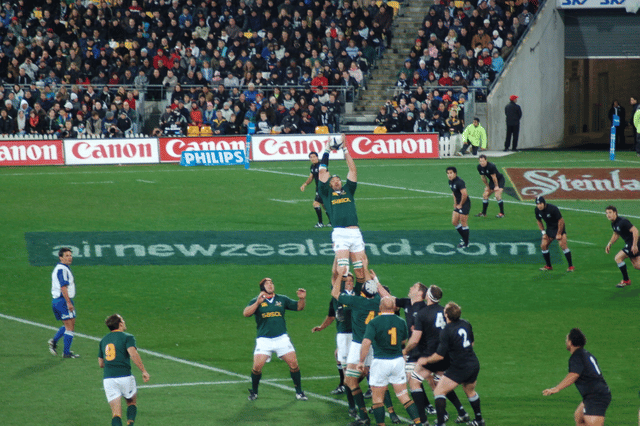
Rugby union

| Highest governing body | World Rugby |
|---|---|
| Nicknames | Rugby, Rugger, Rugby XV, Union[6] |
| First played | 19th century |
| Registered players | 3,560,000[7][4] |
| Clubs | 180,630 |
| Characteristics | |
| Contact | Full contact |
| Team members | 15 (with up to 8 substitutes) |
| Mixed gender | Separate competitions |
| Type | Team sport, Outdoor |
| Equipment | Rugby ball |
| Presence | |
| Olympic | Part of the Summer Olympic programme in 1900, 1908, 1920 and 1924 Rugby sevens included in 2016 |
Rugby union, widely known simply as rugby, is a contact team sport which originated in England in the first half of the 19th century. One of the two codes of rugby football, it is based on running with the ball in hand. In its most common form, a game is between two teams of 15 players using an oval-shaped ball on a rectangular field with H-shaped goalposts at each end.
Rugby union is a popular sport around the world, played by male and female players of all ages. In 2014, there were more than 6 million people playing worldwide, of whom 2.36 million were registered players. World Rugby, previously called the International Rugby Football Board (IRFB) and the International Rugby Board (IRB), has been the governing body for rugby union since 1886, and currently has 101 countries as full members and 18 associate members.
In 1845, the first football laws were written by Rugby School pupils; other significant events in the early development of rugby include the Blackheath Club's decision to leave the Football Association in 1863 and the split between rugby union and rugby league in 1895. Historically an amateur sport, in 1995 restrictions on payments to players were removed, making the game openly professional at the highest level for the first time.[8]
Rugby union spread from the Home Nations of Great Britain and Ireland and was absorbed by many of the countries associated with the British Empire. Early exponents of the sport included Australia, New Zealand, South Africa and France. Countries that have adopted rugby union as their de facto national sport include Fiji, Georgia, Madagascar,[9] New Zealand, Samoa and Tonga.
International matches have taken place since 1871 when the first game took place between Scotland and England at Raeburn Place in Edinburgh. The Rugby World Cup, first held in 1987, takes place every four years. The Six Nations Championship in Europe and The Rugby Championship in the Southern Hemisphere are other major international competitions, held annually.
National club or provincial competitions include the Premiership in England, the Top 14 in France, the Mitre 10 Cup in New Zealand, the National Rugby Championship in Australia, and the Currie Cup in South Africa. Other transnational club competitions include the Pro14 in Europe and South Africa, the European Rugby Champions Cup solely in Europe, and Super Rugby, in the Southern Hemisphere and Japan.
| Highest governing body | World Rugby |
|---|---|
| Nicknames | Rugby, Rugger, Rugby XV, Union[6] |
| First played | 19th century |
| Registered players | 3,560,000[7][4] |
| Clubs | 180,630 |
| Characteristics | |
| Contact | Full contact |
| Team members | 15 (with up to 8 substitutes) |
| Mixed gender | Separate competitions |
| Type | Team sport, Outdoor |
| Equipment | Rugby ball |
| Presence | |
| Olympic | Part of the Summer Olympic programme in 1900, 1908, 1920 and 1924 Rugby sevens included in 2016 |
History

Rugby School in Rugby, Warwickshire, with a rugby football pitch in the foreground
The origin of rugby football is reputed to be an incident during a game of English school football at Rugby School in 1823, when William Webb Ellis is said to have picked up the ball and run with it.[10] Although the evidence for the story is doubtful, it was immortalised at the school with a plaque unveiled in 1895.[11][12] Despite the doubtful evidence, the Rugby World Cup trophy is named after Webb Ellis. Rugby football stems from the form of game played at Rugby School, which former pupils then introduced to their university.
Old Rugbeian Albert Pell, a student at Cambridge, is credited with having formed the first "football" team.[13] During this early period different schools used different rules, with former pupils from Rugby and Eton attempting to carry their preferred rules through to their universities.[14] A significant event in the early development of rugby football was the production of the first written laws of the game at Rugby School in 1845,[15][16] which was followed by the Cambridge Rules drawn up in 1848.[17]
In 1863, The Football Association was formed and began codifying a set of football rules. The FA's rules forbade players from running with the ball in hand and also banned hacking (kicking players in the shins). The Blackheath Club left the FA in protest of the changes,[18][19] followed by several other clubs which favoured the "Rugby Rules" instead. Although these clubs banned hacking soon after, the split became permanent. The FA's rules became association football. Clubs favouring the Rugby Rules formed the Rugby Football Union in 1871,[18] and their code became known as "rugby football".
In 1895, there was a schism in England in which clubs from Northern England left the RFU over the issue of paying players. This led to the creation of the separate code of rugby league. The existing sport took on the name "rugby union" to differentiate it from rugby league.[20] Despite the sport's full name of rugby union, it is known simply as rugby throughout most of the world.[21]
First internationals
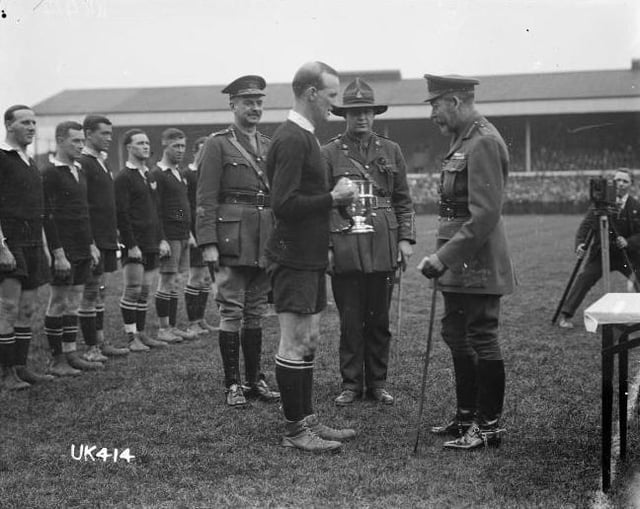
James Ryan, captain of the New Zealand Army team, receiving the Kings Cup from George V.
The first rugby football international was played on 27 March 1871 between Scotland and England in Edinburgh. Scotland won the game 1-0.[18][22] By 1881 both Ireland and Wales had representative teams, and in 1883 the first international competition, the Home Nations Championship had begun. 1883 is also the year of the first rugby sevens tournament, the Melrose Sevens,[23] which is still held annually.
Two important overseas tours took place in 1888: a British Isles team visited Australia and New Zealand—although a private venture, it laid the foundations for future British and Irish Lions tours;[24] and the 1888–89 New Zealand Native football team brought the first overseas team to British spectators.[25]
During the early history of rugby union, a time before commercial air travel, teams from different continents rarely met. The first two notable tours both took place in 1888—the British Isles team touring New Zealand and Australia,[26] followed by the New Zealand team touring Europe.[27] Traditionally the most prestigious tours were the Southern Hemisphere countries of Australia, New Zealand and South Africa making a tour of a Northern Hemisphere, and the return tours made by a joint British and Irish team.[28] Tours would last for months, due to long traveling times and the number of games undertaken; the 1888 New Zealand team began their tour in Hawkes Bay in June and did not complete their schedule until August 1889, having played 107 rugby matches.[29] Touring international sides would play Test matches against international opponents, including national, club and county sides in the case of Northern Hemisphere rugby, or provincial/state sides in the case of Southern Hemisphere rugby.[26][30]
Between 1905 and 1908, all three major Southern Hemisphere rugby countries sent their first touring teams to the Northern Hemisphere: New Zealand in 1905, followed by South Africa in 1906 and Australia in 1908. All three teams brought new styles of play, fitness levels and tactics,[31] and were far more successful than critics had expected.[32]
The New Zealand 1905 touring team performed a haka before each match, leading Welsh Rugby Union administrator Tom Williams to suggest that Wales player Teddy Morgan lead the crowd in singing the Welsh National Anthem, Hen Wlad Fy Nhadau, as a response. After Morgan began singing, the crowd joined in: the first time a national anthem was sung at the start of a sporting event.[33][5] In 1905 France played England in its first international match.[31]
Rugby union was included as an event in the Olympic Games four times during the early 20th century. No international rugby games and union-sponsored club matches were played during the First World War, but competitions continued through service teams such as the New Zealand Army team.[35] During the Second World War no international matches were played by most countries, though Italy, Germany and Romania played a limited number of games,[36][37][38] and Cambridge and Oxford continued their annual University Match.[39]
The first officially sanctioned international rugby sevens tournament took place in 1973 at Murrayfield, one of Scotland's biggest stadiums, as part of the Scottish Rugby Union centenary celebrations.[40]
World Cup and professionalism
In 1987 the first Rugby World Cup was held in Australia and New Zealand, and the inaugural winners were New Zealand. The first World Cup Sevens tournament was held at Murrayfield in 1993. Rugby Sevens was introduced into the Commonwealth Games in 1998 and was added to the Olympic Games of 2016.[41] Both men and women’s Sevens will again take place at the 2020 Olympic Games in Tokyo.[42]
Rugby union was an amateur sport until the IRB declared the game "open" in August 1995 (shortly after the completion of the 1995 World Cup), removing restrictions on payments to players.[43][44] However, the pre-1995 period of rugby union was marked by frequent accusations of "shamateurism",[45] including an investigation in Britain by a House of Commons Select committee in early 1995.[46][47] Following the introduction of professionalism trans-national club competitions were started, with the Heineken Cup in the Northern Hemisphere and Super Rugby in the Southern Hemisphere.[48][49]
The Tri Nations, an annual international tournament involving Australia, New Zealand and South Africa, kicked off in 1996.[49] In 2012, this competition was extended to include Argentina, a country whose impressive performances in international games (especially finishing in third place in the 2007 Rugby World Cup) was deemed to merit inclusion in the competition. As a result of the expansion to four teams, the tournament was renamed The Rugby Championship.[50]
Teams and positions

A standard rugby union team formation illustrating each of the positions and their respective numbers.
Each team starts the match with 15 players on the field and seven or eight substitutes.[51] Players in a team are divided into eight forwards (two more than in rugby league) and seven backs.[52]
Forwards
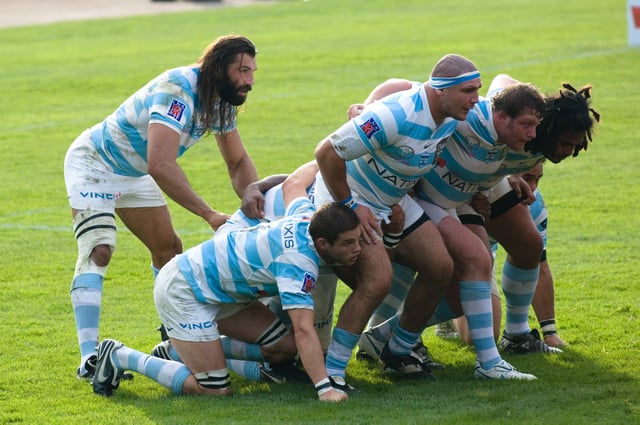
Sébastien Chabal (far left) in number eight position before entering the scrum.
The main responsibilities of the forward players are to gain and retain possession of the ball.[53] Players in these positions are generally bigger and stronger and take part in the scrum and line-out.[53] The forwards are often collectively referred to as the 'pack', especially when in the scrum formation.[54]
Front row The front row consists of three players: two props (the loosehead prop and the tighthead prop) and the hooker. The role of the two props is to support the hooker during scrums, to provide support for the jumpers during line-outs and to provide strength and power in rucks and mauls. The third position in the front row is the hooker. The hooker is a key position in attacking and defensive play and is responsible for winning the ball in the scrum. Hookers normally throw the ball in at line-outs.[52][55]
Second row The second row consists of two locks or lock forwards. Locks are usually the tallest players in the team, and specialize as line-out jumpers.[52] The main role of the lock in line-outs is to make a standing jump, often supported by the other forwards, to either collect the thrown ball or ensure the ball comes down on their side. Locks also have an important role in the scrum, binding directly behind the three front row players and providing forward drive.[52]
Back row The back row, not to be confused with ‘Backs’, is the third and final row of the forward positions, who are often referred to as the loose forwards.[54] The three positions in the back row are the two flankers and the number 8. The two flanker positions called the blindside flanker and openside flanker, are the final row in the scrum. They are usually the most mobile forwards in the game. Their main role is to win possession through 'turn overs'.[52] The number 8 packs down between the two locks at the back of the scrum. The role of the number 8 in the scrum is to control the ball after it has been heeled back from the front of the pack, and the position provides a link between the forwards and backs during attacking phases.[56]
Backs
The backs' role is to create and convert point-scoring opportunities. They are generally smaller, faster and more agile than the forwards.[53] Another distinction between the backs and the forwards is that the backs are expected to have superior kicking and ball-handling skills, especially the fly-half, scrum-half, and full-back.[53]
Half-backs The half-backs consist of two positions, the scrum-half and the fly-half. The fly-half is crucial to a team's game plan, orchestrating the team's performance.[56] They are usually the first to receive the ball from the scrum-half following a breakdown, lineout, or scrum, and need to be decisive with what actions to take and be effective at communicating with the outside backs.[56] Many fly-halves are also their team's goal kickers. The scrum-half is the link between the forwards and the backs.[56] They receive the ball from the lineout and remove the ball from the back of the scrum, usually passing it to the fly-half.[57] They also feed the scrum and sometimes have to act as a fourth loose forward.[58]
Three quarters There are four three quarter positions, the inside centre, outside centre and left and right wings. The centres will attempt to tackle attacking players; whilst in attack, they should employ speed and strength to breach opposition defences.[56] The wings are generally positioned on the outside of the backline. Their primary function is to finish off moves and score tries.[59] Wings are usually the fastest players in the team and are elusive runners who use their speed to avoid tackles.[60]
Fullback The fullback normally positions themself several metres behind the back line. They often field opposition kicks and are usually the last line of defence should an opponent break through the back line.[56] Two of the most important attributes of a good fullback are dependable catching skills and a good kicking game.[61]
Laws
Scoring
Rugby union is played between two teams – the one that scores more points wins the game. Points can be scored in several ways: a try, scored by grounding the ball in the in-goal area (between the goal line and the dead-ball line), is worth 5 points and a subsequent conversion kick scores 2 points; a successful penalty kick or a drop goal each score 3 points.[62] The values of each of these scoring methods have been changed over the years.[63]
Playing field
The field of play on a rugby pitch is as near as possible to a maximum of 144 metres (157 yd) long by 70 metres (77 yd) wide.[64] In actual gameplay the length of a pitch can vary. There are typically 100 metres (109 yd) between the two try-lines, but it can be as short as 94 metres (103 yd). Anywhere between 6 and 22 metres behind each try line serves as the in-goal area. The pitch must be at least 68 metres (74 yd) wide, up to a maximum of 70 metres (76.5 yd) [64]
Rugby goalposts are H-shaped and are situated in the middle of the goal lines at each end of the field. They consist of two poles, 5.6 metres (6.1 yd) apart, connected by a horizontal crossbar 3 metres (3.3 yd) above the ground. The minimum height for posts is 3.4 metres (3.7 yd).[64]
Match structure
At the beginning of the game, the captains and the referee toss a coin to decide which team will kick off first. Play then starts with a dropkick, with the players chasing the ball into the opposition's territory, and the other side trying to retrieve the ball and advance it. If the ball does not reach the opponent's 10-metre line the opposing team has two choices: to have the ball kicked off again, or to have a scrum at the centre of the half-way line.[65] If the player with the ball is tackled, frequently a ruck will result.[66]
Games are divided into 40-minute halves, with a break in the middle.[67] The sides exchange ends of the field after the half-time break.[67] Stoppages for injury or to allow the referee to take disciplinary action do not count as part of the playing time, so that the elapsed time is usually longer than 80 minutes.[67] The referee is responsible for keeping time, even when—as in many professional tournaments—he is assisted by an official time-keeper.[67] If time expires while the ball is in play, the game continues until the ball is "dead", and only then will the referee blow the whistle to signal half-time or full-time; but if the referee awards a penalty or free-kick, the game continues.[67]
In the knockout stages of rugby competitions, most notably the Rugby World Cup, two extra time periods of 10 minutes periods are played (with an interval of 5 minutes in between) if the game is tied after full-time. If scores are level after 100 minutes then the rules call for 20 minutes of sudden-death extra time to be played. If the sudden-death extra time period results in no scoring a kicking competition is used to determine the winner. However, no match in the history of the Rugby World Cup has ever gone past 100 minutes into a sudden-death extra time period.[68]
Passing and kicking
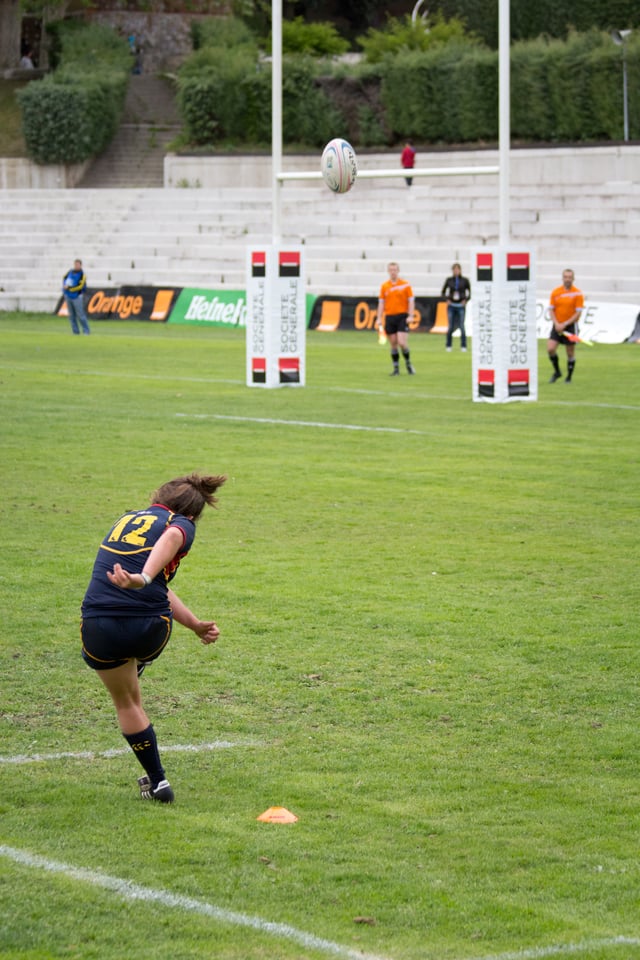
Kicking conversion after a try
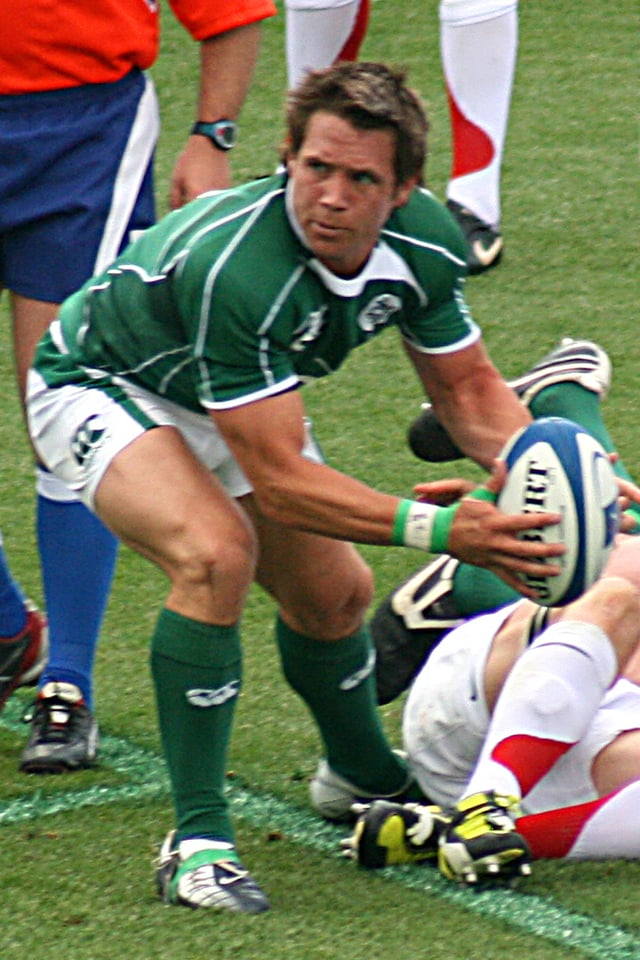
A player about to pass the ball
Forward passing (throwing the ball ahead to another player) is not allowed; the ball can be passed laterally or backwards.[69] The ball tends to be moved forward in three ways — by kicking, by a player running with it or within a scrum or maul. Only the player with the ball may be tackled or rucked. When a ball is knocked forward by a player with their arms, a "knock-on" is committed, and play is restarted with a scrum.[69]
Any player may kick the ball forward in an attempt to gain territory. When a player anywhere in the playing area kicks indirectly into touch so that the ball first bounces in the field of play, the throw-in is taken where the ball went into touch.[70] If the player kicks directly into touch (i.e. without bouncing in-field first) from within one's own 22-metre line, the lineout is taken by the opposition where the ball went into touch, but if the ball is kicked into touch directly by a player outside the 22-metre line, the lineout is taken level to where the kick was taken.[70]
Breakdowns

A rugby tackle: tackles must be below the neck with the aim of impeding or grounding the player with the ball
The aim of the defending side is to stop the player with the ball, either by bringing them to ground (a tackle, which is frequently followed by a ruck) or by contesting for possession with the ball-carrier on their feet (a maul). Such a circumstance is called a breakdown and each is governed by a specific law.
Tackling
A player may tackle an opposing player who has the ball by holding them while bringing them to ground. Tacklers cannot tackle above the shoulder (the neck and head are out of bounds),[71] and the tackler has to attempt to wrap their arms around the player being tackled to complete the tackle. It is illegal to push, shoulder-charge, or to trip a player using feet or legs, but hands may be used (this being referred to as a tap-tackle or ankle-tap).[72][73] Tacklers may not tackle an opponent who has jumped to catch a ball until the player has landed.[71]
Rucking and Mauling
Mauls occur after a player with the ball has come into contact with an opponent but the handler remains on his feet; once any combination of at least three players have bound themselves a maul has been set.[54] A ruck is similar to the maul, but in this case the ball has gone to ground with at least three attacking players binding themselves on the ground in an attempt to secure the ball.[54]
Set pieces
Lineout
When the ball leaves the side of the field, a line-out is awarded against the team which last touched the ball.[74] Forward players from each team line up a metre apart, perpendicular to the touchline and between 5 m and 15 m from the touchline.[74] The ball is thrown from the touchline down the centre of the lines of forwards by a player (usually the hooker) from the team that did not play the ball into touch.[74] The exception to this is when the ball went out from a penalty, in which case the side who gained the penalty throws the ball in.[74]
Scrum

A scrum
A scrum is a way of restarting the game safely and fairly after a minor infringement.[77] It is awarded when the ball has been knocked or passed forward, if a player takes the ball over his own try line and puts the ball down, when a player is accidentally offside or when the ball is trapped in a ruck or maul with no realistic chance of being retrieved. A team may also opt for a scrum if awarded a penalty.[77]
A scrum is formed by the eight forwards from each team binding together in three rows.[77] The front row consists of the two props (loosehead and tighthead) either side of the hooker.[77] The second row consists of two locks and the two flankers. Behind the second row is the number 8. This formation is known as the 3–4–1 formation.[78] Once a scrum is formed the scrum-half from the team awarded the feed rolls the ball into the gap between the two front-rows known as the tunnel.[77] The two hookers then compete for possession by hooking the ball backwards with their feet, while each pack tries to push the opposing pack backwards to help gain possession.[77] The side that wins possession transfers the ball to the back of the scrum, where it is picked up either by the number 8 or by the scrum-half.[77]
Officials and offences
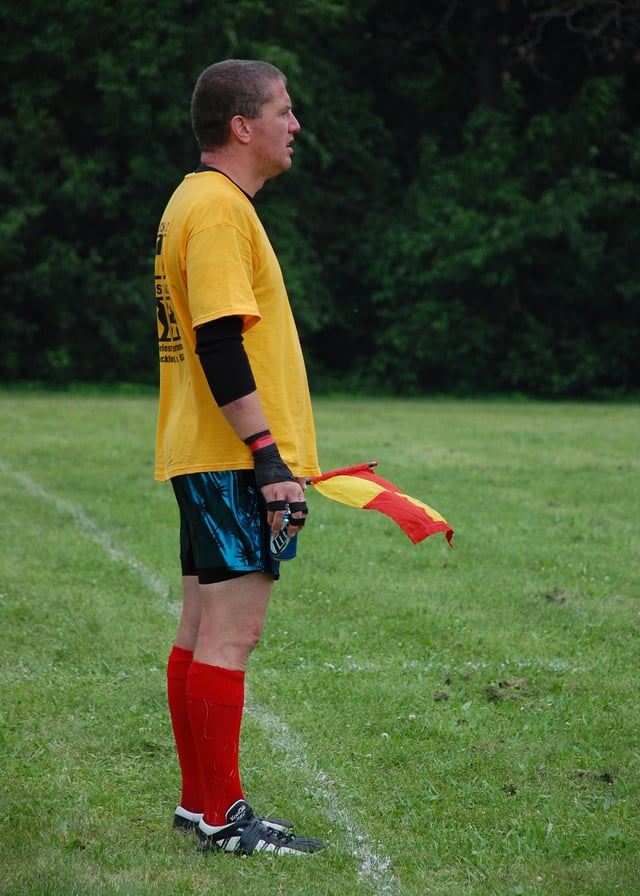
Touch judge with flag.
There are three match officials: a referee, and two assistant referees.[79] The latter, formerly known as touch judges, had the primary function of indicating when the ball had gone into "touch"; their role has been expanded and they are now expected to assist the referee in a number of areas, such as watching for foul play and checking offside lines.[79] In addition, for matches in high level competitions, there is often a television match official (TMO; popularly called the "video referee"), to assist with certain decisions, linked up to the referee by radio.[80] The referees have a system of hand signals to indicate their decisions.[81]
Common offences include tackling above the shoulders, collapsing a scrum, ruck or maul, not releasing the ball when on the ground, or being offside.[82] The non-offending team has a number of options when awarded a penalty: a "tap" kick, when the ball is kicked a very short distance from hand, allowing the kicker to regather the ball and run with it; a punt, when the ball is kicked a long distance from hand, for field position; a place-kick, when the kicker will attempt to score a goal; or a scrum.[82] Players may be sent off (signalled by a red card) or temporarily suspended ("sin-binned") for ten minutes (yellow card) for foul play or repeated infringements, and may not be replaced.[82]
Occasionally, infringements are not caught by the referee during the match and these may be "cited" by the citing commissioner after the match and have punishments (usually suspension for a number of weeks) imposed on the infringing player.[83]
Replacements and substitutions
During the match, players may be replaced (for injury) or substituted (for tactical reasons).[51] A player who has been replaced may not rejoin play unless he was temporarily replaced to have bleeding controlled; a player who has been substituted may return temporarily, to replace a player who has a blood injury or has suffered a concussion, or permanently, if he is replacing a front-row forward.[51] In international matches, eight replacements are allowed; in domestic or cross-border tournaments, at the discretion of the responsible national union(s), the number of replacements may be nominated to a maximum of eight, of whom three must be sufficiently trained and experienced to provide cover for the three front row positions.[51][84]
Prior to 2016, all substitutions, no matter the cause, counted against the limit during a match. In 2016, World Rugby changed the law so that substitutions made to replace a player deemed unable to continue due to foul play by the opposition would no longer count against the match limit. This change was introduced in January of that year in the Southern Hemisphere and June in the Northern Hemisphere.[85]
Equipment
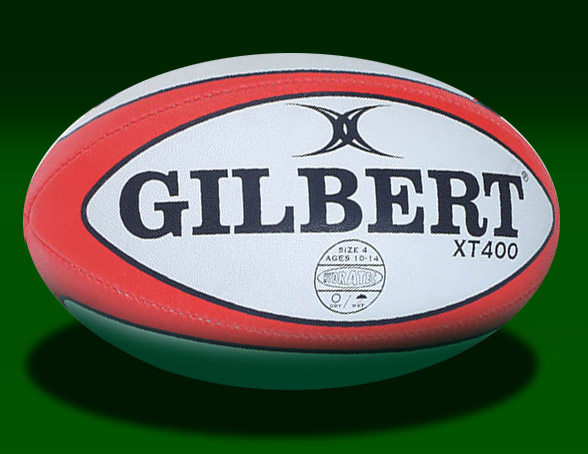
A synthetic rugby ball by Gilbert
The most basic items of equipment for a game of rugby union are the ball itself, a rugby shirt (also known as a "jersey"), rugby shorts, socks, and boots. The rugby ball is oval in shape (technically a prolate spheroid), and is made up of four panels.[86] The ball was historically made of leather, but in the modern era most games use a ball made from a synthetic material. The WR lays out specific dimensions for the ball, 280-300mm in length, 740-770mm in circumference of length and 580-620mm in circumference of width.[86] Rugby boots have soles with studs to allow grip on the turf of the pitch. The studs may be either metal or plastic but must not have any sharp edges or ridges.[87]
Protective equipment is optional and strictly regulated. The most common items are mouthguards, which are worn by almost all players, and are compulsory in some rugby-playing nations.[88] Other protective items that are permitted include head gear; thin (not more than 10 mm thick), non-rigid shoulder pads and shin guards; which are worn underneath socks.[87] Bandages or tape can be worn to support or protect injuries; some players wear tape around the head to protect the ears in scrums and rucks. Female players may also wear chest pads.[87] Although not worn for protection, some types of fingerless mitts are allowed to aid grip.[87]
It is the responsibility of the match officials to check players' clothing and equipment before a game to ensure that it conforms to the laws of the game.[87]
Governing bodies

Member and Associated Unions Member Union Associated Union
The international governing body of rugby union (and associated games such as sevens) is World Rugby (WR).[89] The WR headquarters are in Dublin, Ireland.[89] WR, founded in 1886, governs the sport worldwide and publishes the game's laws and rankings.[89] As of February 2014, WR (then known as the IRB, for International Rugby Board) recorded 119 unions in its membership, 101 full members and 18 associate member countries.[7] According to WR, rugby union is played by men and women in over 100 countries.[89] WR controls the Rugby World Cup,[89] the Women's Rugby World Cup,[90] Rugby World Cup Sevens,[91] HSBC Sevens Series,[92] HSBC Women's Sevens Series,[93] World Under 20 Championship,[94] World Under 20 Trophy,[95] Nations Cup[96] and the Pacific Nations Cup.[97] WR holds votes to decide where each of these events are to be held, except in the case of the Sevens World Series for men and women, for which WR contracts with several national unions to hold individual events.
Six regional associations, which are members of WR, form the next level of administration; these are:
Rugby Africa, formerly Confederation of African Rugby (CAR)[98]
Asia Rugby, formerly Asian Rugby Football Union (ARFU)[99]
Rugby Americas North, formerly North America Caribbean Rugby Association (NACRA)[100]
Rugby Europe, previously Fédération Internationale de Rugby Amateur – Association Européenne de Rugby (FIRA-AER)[101]
Oceania Rugby, formerly Federation of Oceania Rugby Unions (FORU)[102]
Sudamérica Rugby, formerly Confederación Sudamericana de Rugby (South American Rugby Confederation, or CONSUR)[103]
SANZAAR (South Africa, New Zealand, Australia and Argentina Rugby) is a joint venture of the South African Rugby Union, New Zealand Rugby, Rugby Australia and the Argentine Rugby Union (UAR) that operates Super Rugby and The Rugby Championship (formerly the Tri Nations before the entry of Argentina).[104] Although UAR initially had no representation on the former SANZAR board, it was granted input into the organisation's issues, especially with regard to The Rugby Championship,[105] and became a full SANZAAR member in 2016 (when the country entered Super Rugby).
National unions oversee rugby union within individual countries and are affiliated to WR. Since 2016, the WR Council has 40 seats. A total of 11 unions—the eight foundation unions of Scotland, Ireland, Wales, England, Australia, New Zealand, South Africa and France, plus Argentina, Canada and Italy—have two seats each. In addition, the six regional associations have two seats each. Four more unions—Georgia, Japan, Romania and the USA—have one seat each. Finally, the Chairman and Vice Chairman, who usually come from one of the eight foundation unions (although the current Vice Chairman, Agustín Pichot, is with the non-foundation Argentine union) have one vote each.[106][89]
Global reach
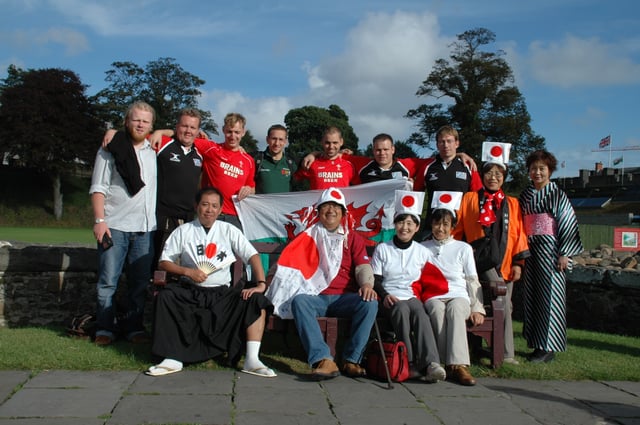
Japanese and Welsh rugby fans in Cardiff, Wales
The earliest countries to adopt rugby union were England, the country of inception, and the other three Home Nations, Scotland, Ireland and Wales. The spread of rugby union as a global sport has its roots in the exporting of the game by British expatriates, military personnel, and overseas university students. The first rugby club in France was formed by British residents in Le Havre in 1872, while the next year Argentina recorded its first game: 'Banks' v 'City' in Buenos Aires.[107]
Oceania
A rugby club was formed in Sydney, New South Wales, Australia in 1864; while the sport was said to have been introduced to New Zealand by Charles Monro in 1870, who played rugby while a student at Christ's College, Finchley.[18]
Several island nations have embraced the sport of rugby. Rugby was first played in Fiji circa 1884 by European and Fijian soldiers of the Native Constabulary at Ba on Viti Levu island.[116][117] Fiji then sent their first overseas team to Samoa in 1924, who in turn set up their own union in 1927.[118] Along with Tonga, other countries to have national rugby teams in Oceania include the Cook Islands, Niue, Papua New Guinea and Solomon Islands.[119]
North America and Caribbean
In North America a club formed in Montreal in 1868, Canada's first club. The city of Montreal also played its part in the introduction of the sport in the United States, when students of McGill University played against a team from Harvard University in 1874.[18][107]
Although the exact date of arrival of rugby union in Trinidad and Tobago is unknown, their first club Northern RFC was formed in 1923, a national team was playing by 1927 and due to a cancelled tour to British Guiana in 1933, switched their venue to Barbados; introducing rugby to the island.[120][121] Other Atlantic countries to play rugby union include Jamaica[122] and Bermuda.[123]
Europe
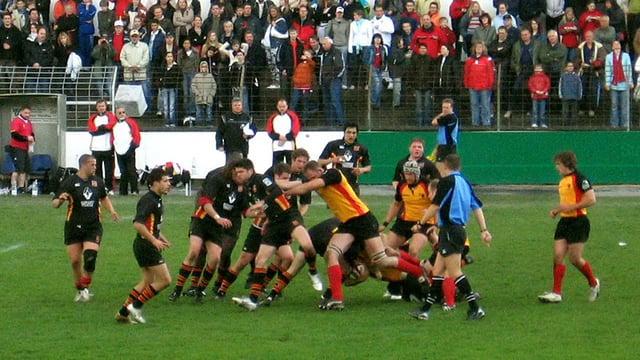
Germany playing Belgium
The growth of rugby union in Europe outside the 6 Nations countries in terms of playing numbers has been sporadic. Historically, British and Irish home teams played the Southern Hemisphere teams of Australia, New Zealand, and South Africa, as well as France. The rest of Europe were left to play amongst themselves. During a period when it had been isolated by the British and Irish Unions, France, lacking international competition, became the only European team from the top tier to regularly play the other European countries; mainly Belgium, the Netherlands, Germany, Spain, Romania, Poland, Italy and Czechoslovakia.[101][124] In 1934, instigated by the French Rugby Federation, FIRA (Fédération Internationale de Rugby Amateur) was formed to organise rugby union outside the authority of the IRFB.[101] The founding members were Italy, Romania, Netherlands, Portugal, Czechoslovakia, and Sweden.
Other European rugby playing nations of note include Russia, whose first officially recorded match is marked by an encounter between Dynamo Moscow and the Moscow Institute of Physical Education in 1933.[125] Rugby union in Portugal also took hold between the First and Second World Wars, with a Portuguese National XV set up in 1922 and an official championship started in 1927.[126]
In 1999, FIRA agreed to place itself under the auspices of the IRB, transforming itself into a strictly European organising body. Accordingly, it changed its name to FIRA–AER (Fédération Internationale de Rugby Amateur – Association Européenne de Rugby). It adopted its current name of Rugby Europe in 2014.
South America
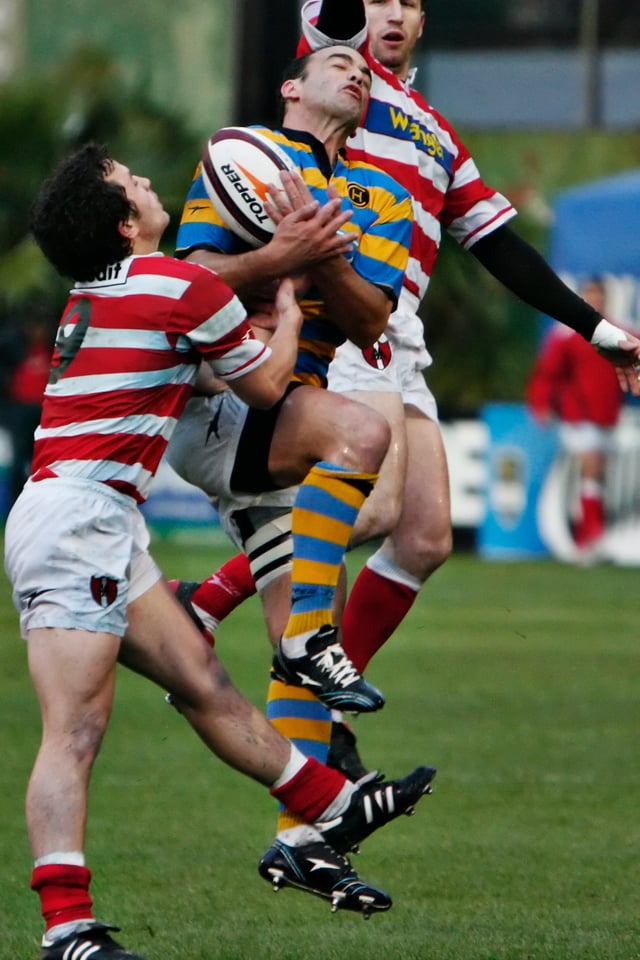
Argentine teams Alumni and Hindú playing the Torneo de la URBA final match in 2007.
Although Argentina is the best-known rugby playing nation in South America, founding the Argentine Rugby Union in 1899,[127] several other countries on the continent have a long history. Rugby had been played in Brazil since the end of the 19th century, but the game was played regularly only from 1926, when São Paulo beat Santos in an inter-city match.[128] It took Uruguay several aborted attempts to adapt to rugby, led mainly by the efforts of the Montevideo Cricket Club; these efforts succeeded in 1951 with the formation of a national league and four clubs.[129] Other South American countries that formed a rugby union include Chile (1948),[130] and Paraguay (1968).[131]
Asia

Ivory Coast before their 2011 World Cup qualifier vs. Zambia on 21 July 2008.
Many Asian countries have a tradition of playing rugby dating from the British Empire. India began playing rugby in the early 1870s, the Calcutta Football Club forming in 1873. However, with the departure of a local British army regiment, interest in rugby diminished in the area.[132] In 1878, The Calcutta Football Club was disbanded, and rugby in India faltered.[133] Sri Lanka claims to have founded their union in 1878, and although little official information from the period is available, the team won the All-India cup in Madras in 1920.[134] The first recorded match in Malaysia was in 1892, but the first confirmation of rugby is the existence of the HMS Malaya Cup which was first presented in 1922 and is still awarded to the winners of the Malay sevens.[135]
Rugby union was introduced to Japan in 1899 by two Cambridge students: Ginnosuke Tanaka and Edward Bramwell Clarke.[136][137] The Japan RFU was founded in 1926 and its place in rugby history was cemented with the news that Japan will host the 2019 World Cup.[138] It will be the first country outside the Commonwealth, Ireland and France to host the event, and this is viewed by the IRB as an opportunity for rugby union to extend its reach,[138] particularly in Asia. Other Asian playing countries of note include Singapore, South Korea, China and The Philippines, while the former British colony of Hong Kong is notable within rugby for its development of the rugby sevens game, especially the Hong Kong Sevens tournament which was founded in 1976.[139]
Rugby in the Middle East and the Gulf States has its history in the 1950s, with clubs formed by British and French Services stationed in the region after the Second World War.[140] When these servicemen left, the clubs and teams were kept alive by young professionals, mostly Europeans, working in these countries. The official union of Oman was formed in 1971.[141] Bahrain founded its union a year later, while in 1975 the Dubai Sevens, the Gulf's leading rugby tournament, was created. Rugby remains a minority sport in the region with Israel, as of 2011, being the only member union from the Middle East to be included in the IRB World Rankings.[142]
Africa
In 1875, rugby was introduced to South Africa by British soldiers garrisoned in Cape Town.[107] During the late 19th and early 20th century, the sport in Africa was spread by settlers and colonials who often adopted a "whites-only" policy to playing the game. This resulted in rugby being viewed as a bourgeois sport by the indigenous people with limited appeal.[143] The earliest countries to see the playing of competitive rugby include South Africa, and neighbouring Rhodesia (modern-day Zimbabwe), which formed the Rhodesia Rugby Football Union in 1895.[144]
In more recent times the sport has been embraced by several African nations. In the early 21st century Madagascar has experienced crowds of 40,000 at national matches,[145] while Namibia, whose history of rugby can be dated from 1915, have qualified for the final stages of the World Cup four times since 1999.[146] Other African nations to be represented in the World Rugby Rankings as Member Unions include Côte d'Ivoire, Kenya, Uganda and Zambia.[142] South Africa and Kenya are among the 15 "core teams" that participate in every event of the men's World Rugby Sevens Series.[147]
Women's rugby union

US women's rugby: NC Hustlers vs. Midwest II
Records of women's rugby football date from the late 19th century, with the first documented source being Emily Valentine's writings, stating that she set up a rugby team in Portora Royal School in Enniskillen, Ireland in 1887.[148] Although there are reports of early women's matches in New Zealand and France, one of the first notable games to prove primary evidence was the 1917 war-time encounter between Cardiff Ladies and Newport Ladies; a photo of which shows the Cardiff team before the match at the Cardiff Arms Park.[149] In the past 30 years the game has grown in popularity among female athletes, and, according to WR, is now played in over 100 countries.[150]
The English-based Women's Rugby Football Union (WRFU), responsible for women's rugby in England, Scotland, Ireland, and Wales, was founded in 1983, and is the oldest formally organised national governing body for women's rugby.[151] This was replaced in 1994 by the Rugby Football Union for Women (RFUW) in England with each of the other Home Nations governing their own countries.[151] The premier international competition in rugby union for women is the Women's Rugby World Cup, first held in 1991.[152] From 1994 through 2014, it was held every four years.[152] Following the 2014 event, a new four-year cycle was instituted, with the Women's World Cup held in the middle year of the men's World Cup cycle. The new Women's World Cup cycle began in 2017, with future competitions every four years thereafter.
Major international competitions
Rugby World Cup

A giant rugby ball suspended from the Eiffel Tower commemorates France's hosting of the 2007 World Cup.
The most important tournament in rugby union is the Rugby World Cup, a men's tournament that has taken place every four years since 1987 among national rugby union teams. New Zealand has won the Rugby World Cup the most (3 times) and is the current cup holder, winning the 2015 Rugby World Cup held at Twickenham, beating Australia in the final.[153][154] England (2003) are the only team from the Northern Hemisphere to win, the reigning champions being New Zealand (1987, 2011 and 2015) with Australia crowned champions 1991 and 1999, and South Africa 1995 and 2007.[154]
The Rugby World Cup has continued to grow since its inception in 1987.[155] The first tournament, in which 16 teams competed for the title, was broadcast to 17 countries with an accumulated total of 230 million television viewers.[155] Ticket sales during the pool stages and finals of the same tournament was less than a million.[155] The 2007 World Cup was contested by 94 countries with ticket sales of 3,850,000 over the pool and final stage.[155] The accumulated television audience for the event, then broadcast to 200 countries, was a claimed 4.2 billion.[155]
The 2019 Rugby World Cup will take place in Japan from 20 September to 2 November. It will be the ninth edition and the first time the tournament has been held in Asia. [156]
Regional tournaments
Major international competitions are the Six Nations Championship and The Rugby Championship, held in Europe and the Southern Hemisphere respectively.[157]
The Six Nations is an annual competition involving the European teams England, France, Ireland, Italy, Scotland and Wales.[158] Each country plays the other five once. After the initial internationals between England and Scotland, Ireland and Wales began competing in the 1880s, forming the Home International Championships.[158] France joined the tournament in the 1900s and in 1910 the term Five Nations first appeared.[158] However, the Home Nations (England, Ireland, Scotland, and Wales) excluded France in 1931 amid a run of poor results, allegations of professionalism and concerns over on-field violence.[159] France then rejoined in 1939–1940, though World War II halted proceedings for a further eight years.[158] France has played in all the tournaments since WWII, the first of which was played in 1947.[158] In 2000, Italy became the sixth nation in the contest and Rome's Stadio Olimpico has replaced Stadio Flaminio as the venue for their home games since 2013.[160] The current Six Nations champions are Wales.
The Rugby Championship is the Southern Hemisphere's annual international series for that region's top national teams. From its inception in 1996 through 2011, it was known as the Tri Nations, as it featured the hemisphere's traditional powers of Australia, New Zealand and South Africa.[161] These teams have dominated world rankings in recent years, and many considered the Tri Nations to be the toughest competition in international rugby.[162][163] The Tri Nations was initially played on a home and away basis with the three nations playing each other twice.
In 2006 a new system was introduced where each nation plays the others three times, though in 2007 and 2011 the teams played each other only twice, as both were World Cup years.[161] Since Argentina's strong performances in the 2007 World Cup,[164] after the 2009 Tri Nations tournament, SANZAR (South Africa, New Zealand and Australian Rugby) invited the Argentine Rugby Union (UAR) to join an expanded Four Nations tournament in 2012.[165] The competition has been officially rechristened as The Rugby Championship beginning with the 2012 edition. The competition reverted to the Tri Nations' original home-and-away format, but now involving four teams. In World Cup years, an abbreviated tournament is held in which each team plays the others only once.
Rugby within multi-sport events
Rugby union was played at the Olympic Games in 1900, 1908, 1920 and 1924.[166] As per Olympic rules, the nations of Scotland, Wales and England were not allowed to play separately as they are not sovereign states. In 1900, France won the gold, beating Great Britain 27 points to 8 and defeating Germany 27 points to 17.[166] In 1908, Australia defeated Great Britain, claiming the gold medal, the score being 32 points to three.[166] In 1920, the United States, fielding a team with many players new to the sport of rugby, upset France in a shock win, eight points to zero. In 1924, the United States again defeated France 17 to 3, becoming the only team to win gold twice in the sport.[166]
In 2009 the International Olympic Committee voted with a majority of 81 to 8 that rugby union be reinstated as an Olympic sport in at least the 2016 and 2020 games, but in the sevens, 4-day tournament format.[41][167] This is something the rugby world has aspired to for a long time and Bernard Lapasset, president of the International Rugby Board, said the Olympic gold medal would be considered to be "the pinnacle of our sport" (Rugby Sevens).[168]
Rugby sevens has been played at the Commonwealth Games since the 1998 Games in Kuala Lumpur.[169] The most gold medal holders are New Zealand who have won the competition on four successive occasions until South Africa beat them in 2014.[170] Rugby union has also been an Asian Games event since the 1998 games in Bangkok, Thailand. In the 1998 and 2002 editions of the games, both the usual fifteen-a-side variety and rugby sevens were played, but from 2006 onwards, only rugby sevens was retained. In 2010, the women's rugby sevens event was introduced. The event is likely to remain a permanent fixture of the Asian Games due to elevation of rugby sevens as an Olympic sport from the 2016 Olympics onwards. The present gold medal holders in the sevens tournament, held in 2014, are Japan in the men's event and China in the women's.
Women's international rugby
The first Women's Rugby World Cup was held in Wales in 1991, and was won by the United States.[152] The second tournament took place in 1994, and from that time through 2014 was held every four years. The New Zealand Women's team then won four straight World Cups (1998, 2002, 2006, 2010)[173] before England won in 2014. Following the 2014 event, World Rugby moved the next edition of the event to 2017, with a new four-year cycle from that point forward.[174] New Zealand are the current World Cup holders.
As well as the Women's Rugby World Cup there are also other regular tournaments, including a Six Nations, run in parallel to the men's competition. The Women's Six Nations, first played in 1996 has been dominated by England, who have won the tournament on 14 occasions, including a run of seven consecutive wins from 2006 to 2012. However, since then, England have won only in 2017; reigning champion France have won in each even-numbered year (2014, 2016, 2018) whilst Ireland won in 2013 and 2015.
Professional rugby
Rugby union has been professionalized since 1995. The following table shows fully professional rugby competitions. (Semi-professional competitions are excluded.)
| Competition | Teams | Countries | Average Attendance |
|---|---|---|---|
| Super Rugby | 15[1] | New Zealand (5), Australia (4), South Africa (4), Argentina (1), Japan (1) | 20,384 |
| Premiership | 12 | England | 15,065 |
| Top 14 | 14 | France | 13,207 |
| Currie Cup | 9 | South Africa | 11,125 |
| Pro14 | 14 | Ireland (4), Wales (4), Scotland (2), Italy (2), South Africa (2)[2] | 8,586 |
| Mitre 10 Cup | 14 | New Zealand | 7,203 |
| Rugby Pro D2 | 16 | France | 4,222 |
| RFU Championship | 12 | England | 2,738 |
| Major League Rugby | 9 | Canada (1), United States (8) | 2,300 (in 2018) |
| NRC | 8[3] | Australia (7), Fiji (1) | 1,450 |
| Didi 10 | 10 | Georgia | Unknown |
| Rugby Premier League | 8 | Russia | Unknown |
Variants

Beach rugby match
Rugby union has spawned several variants of the full-contact, 15-a-side game. The two most common differences in adapted versions are fewer players and reduced player contact.
The oldest variant is rugby sevens (sometimes 7s or VIIs), a fast-paced game which originated in Melrose, Scotland in 1883. In rugby sevens, there are only seven players per side, and each half is normally seven minutes. Major tournaments include the Hong Kong Sevens and Dubai Sevens, both held in areas not normally associated with the highest levels of the 15-a-side game.
A more recent variant of the sport is rugby tens (10s or Xs), a Malaysian invention with ten players per side.[175]
Tag Rugby is a version in which the players wear a belt with two tags attached by velcro, the removal of either counting as a 'tackle'. Tag Rugby also varies in that kicking the ball is not allowed.[181] Similar to Tag Rugby, American Flag Rugby, (AFR), is a mixed gender, non-contact imitation of rugby union designed for American children entering grades K-9.[182] Both American Flag Rugby and Mini Rugby differ to Tag Rugby in that they introduce more advanced elements of rugby union as the participants age.[179]
Influence on other sports
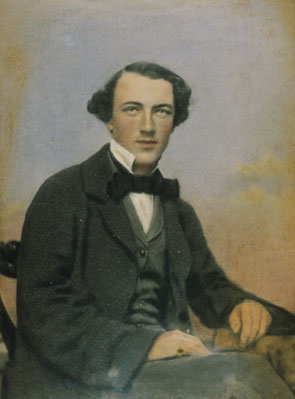
When codifying Australian rules football in 1859, Tom Wills drew inspiration from an early version of rugby he learnt at Rugby School.
Rugby league was formed after the Northern Union broke from the Rugby Football Union in a disagreement over payment to players. It went on to change its laws and became a code in its own right. The two sports continue to influence each other to this day.
American football[184][185] and Canadian football[186] are derived from early forms of rugby.[186]
Australian rules football was influenced by rugby football and other games originating in English public schools.[187][188][189]
James Naismith took aspects of many sports including rugby to invent basketball.[190] The most obvious contribution is the jump ball's similarity to the line-out as well as the underhand shooting style that dominated the early years of the sport. Naismith played rugby at McGill University.[191]
Rugby lends its name to wheelchair rugby, a full-contact sport which contains elements of rugby such as crossing a try line with the ball to score.[194]
Statistics and records
According to a 2011 report by the Centre for the International Business of Sport, over four and a half million people play rugby union or one of its variants organised by the IRB.[195] This is an increase of 19 percent since the previous report in 2007.[196] The report also claimed that since 2007 participation has grown by 33 percent in Africa, 22 percent in South America and 18 percent in Asia and North America.[196] In 2014 the IRB published a breakdown of the total number of players worldwide by national unions. It recorded a total of 6.6 million players globally, of those, 2.36 million were registered members playing for a club affiliated to their country's union.[7] The 2016 World Rugby Year in Review reported 8.5 million players, of which 3.2 million were registered union players and 1.9 million were registered club players; 22% of all players were female.[197]
The most capped international player from the tier 1 nations is former New Zealand openside flanker and captain Richie McCaw who has played in 148 internationals.[198] While the top scoring tier 1 international player is New Zealand's Dan Carter, who has amassed 1442 points during his career.[199] In April 2010 Lithuania which is a second tier rugby nation, broke the record of consecutive international wins for second tier rugby nations. In 2016, the All Blacks of New Zealand set the new record 18 consecutive test wins among tier 1 rugby nations, bettering their previous consecutive run of 17.[200] This record was equalled by England on 11 March 2017 with a win over Scotland at Twickenham.[201] The highest scoring international match between two recognised unions was Hong Kong's 164–13 victory over Singapore on 27 October 1994.[202] While the largest winning margin of 152 points is held by two countries, Japan (a 155–3 win over Chinese Taipei) and Argentina (152–0 over Paraguay) both in 2002.[202]
The record attendance for a rugby union game was set on 15 July 2000 in which New Zealand defeated Australia 39–35 in a Bledisloe Cup game at Stadium Australia in Sydney before 109,874 fans.[203] The record attendance for a match in Europe of 104,000 (at the time a world record) was set on 1 March 1975 when Scotland defeated Wales 12–10 at Murrayfield in Edinburgh during the 1975 Five Nations Championship.[203] The record attendance for a domestic club match is 99,124, set when Racing 92 defeated Toulon in the 2016 Top 14 final on 24 June at Camp Nou in Barcelona. The match had been moved from its normal site of Stade de France near Paris due to scheduling conflicts with France's hosting of UEFA Euro 2016.[204]
In culture
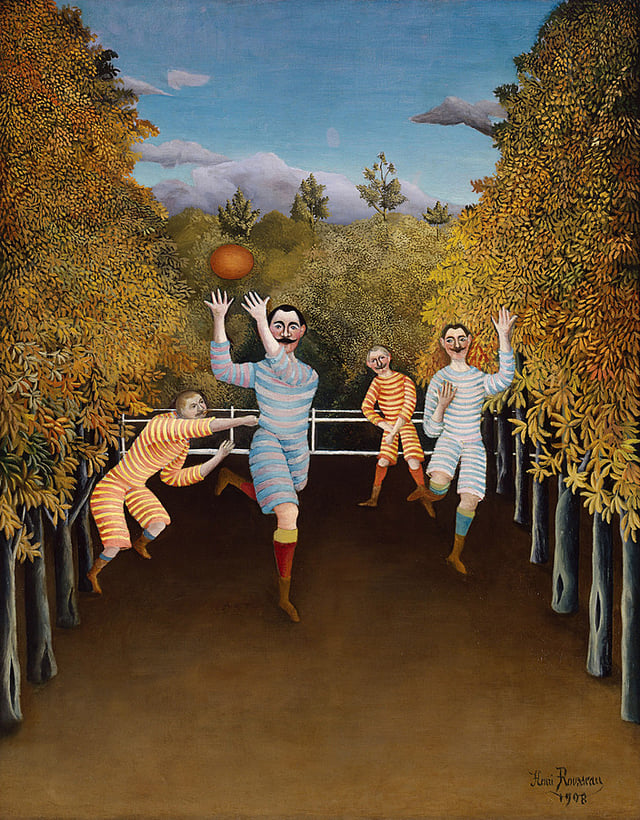
Henri Rousseau – The Football Players (1908)
Thomas Hughes 1857 novel Tom Brown's Schooldays, set at Rugby School, includes a rugby football match, also portrayed in the 1940s film of the same name. James Joyce mentions Irish team Bective Rangers in several of his works, including Ulysses (1922) and Finnegans Wake (1939), while his 1916 semi-autobiographical work A Portrait of the Artist as a Young Man has an account of Ireland international James Magee.[205] Sir Arthur Conan Doyle, in his 1924 Sherlock Holmes tale The Adventure of the Sussex Vampire, mentions that Dr Watson played rugby for Blackheath.[206]
Henri Rousseau's 1908 work Joueurs de football shows two pairs of rugby players competing.[207] Other French artists to have represented the sport in their works include Albert Gleizes' Les Joueurs de football (1912), Robert Delaunay's Football. L'Équipe de Cardiff (1916) and André Lhote's Partie de Rugby (1917).[208] The 1928 Gold Medal for Art at the Antwerp Olympics was won by Luxembourg's Jean Jacoby for his work Rugby.[209]
In film, Ealing Studios' 1949 comedy A Run for Your Money and the 1979 BBC Wales television film Grand Slam both centre on fans attending a match.[210] Films that explore the sport in more detail include independent production Old Scores (1991) and Forever Strong (2008). Invictus (2009), based on John Carlin's book Playing the Enemy, explores the events of the 1995 Rugby World Cup and Nelson Mandela's attempt to use the sport to connect South Africa's people post-apartheid.[211][212]
In public art and sculpture there are many works dedicated to the sport. There is a 27 ft bronze statue of a rugby line-out by pop artist Gerald Laing at Twickenham[213] and one of rugby administrator Sir Tasker Watkins at the Millennium Stadium.[214] Rugby players to have been honoured with statues include Gareth Edwards in Cardiff and Danie Craven in Stellenbosch.[215]
See also
Experimental law variations
International Rugby Hall of Fame, now merged with the former IRB Hall of Fame
World Rugby Hall of Fame, a merger of the IRB and International Rugby Halls of Fame
List of international rugby union teams
List of oldest rugby union competitions
List of rugby union terms